1 of 28
Downloaded 29 times
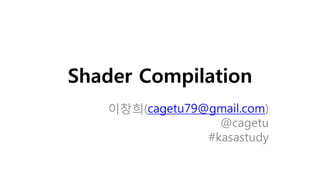

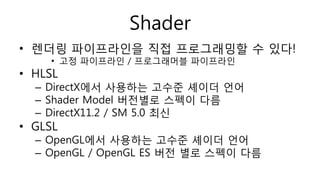

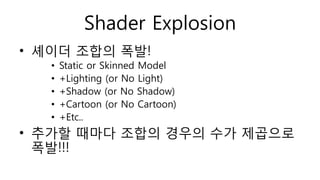
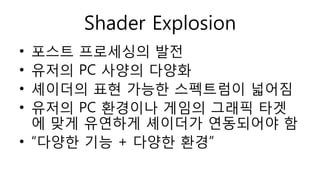
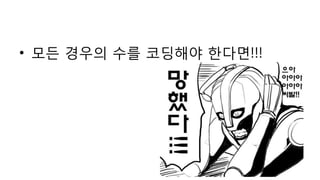

![[UDK : DefaultVertexShader.msf]](https://image.slidesharecdn.com/shadercompilation-140725023104-phpapp01/85/Shader-compilation-9-320.jpg)
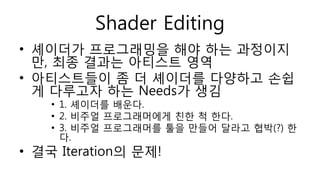
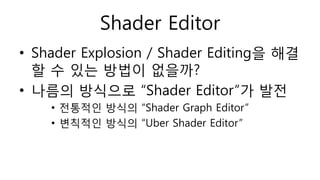




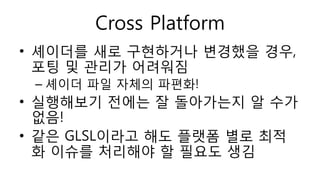






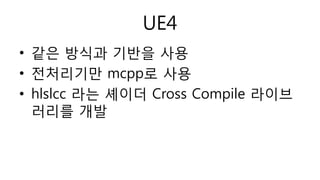
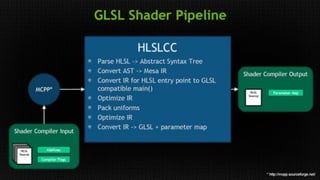
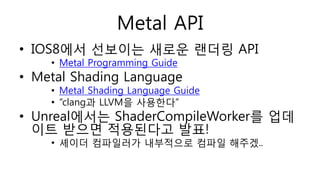

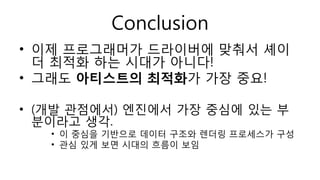
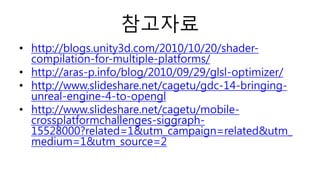
Ad
Recommended
[NDC17] Protocol:hyperspace Diver Ļ░£ļ░£ ĒżņŖżĒŖĖļ¬©Ēģ£
[NDC17] Protocol:hyperspace Diver Ļ░£ļ░£ ĒżņŖżĒŖĖļ¬©Ēģ£Young Soo Kim
╠²
Protocol:hyperspace Diver Ļ░£ļ░£ ĒżņŖżĒŖĖļ¬©Ēģ£
- ņŚöņ¦ä Ļ░£ļ░£ļČĆĒä░ ņŗ£ņ×æĒĢśļŖö ļ¬©ļ░öņØ╝ ņØĖļöö ļ”¼ļō¼Ļ▓īņ×ä Ļ░£ļ░£
NDC17ņŚÉņä£ ļ░£Ēæ£ĒĢ£ ņäĖņģśņØś ņ×ÉļŻīļź╝ Ļ│Ąņ£ĀĒĢ®ļŗłļŗż.
ņŖ¼ļØ╝ņØ┤ļō£ļŖö https://goo.gl/EiUCgk ņŚÉņä£ļÅä ļŗżņÜ┤ļĪ£ļō£ ļ░øņ£╝ņŗż ņłś ņ׳ņŖĄļŗłļŗż.ņĢäĒŗ░ņŖżĒŖĖņŚÉĻ▓ī ņé¼ļ×æļ░øļŖö 3DS Max ņÜ░ļ▓äņēÉņØ┤ļŹö
ņĢäĒŗ░ņŖżĒŖĖņŚÉĻ▓ī ņé¼ļ×æļ░øļŖö 3DS Max ņÜ░ļ▓äņēÉņØ┤ļŹöĒżĒöä Ļ╣Ć
╠²
KGC 2013 Ļ░ĢņŚ░ņ×ÉļŻīņ×ģļŗłļŗż. ņŖżĒÄśņØ┤ņŖżļ¦łļ”░ņŚÉņä£ ņé¼ņÜ®Ē¢łļŹś ņĢäĒŗ░ņŖżĒŖĖņØś ļłłļåÆņØ┤ņŚÉ ļ¦×ņČś 3DS Max ņÜ░ļ▓ä ņģ░ņØ┤ļŹöņ×ģļŗłļŗż.
ņä£ļ▓äņÖĆ Ēü┤ļØ╝ņØ┤ņ¢ĖĒŖĖ Ļ░ÖņØĆ ņŚöņ¦ä ņé¼ņÜ®ĒĢśĻĖ░
ņä£ļ▓äņÖĆ Ēü┤ļØ╝ņØ┤ņ¢ĖĒŖĖ Ļ░ÖņØĆ ņŚöņ¦ä ņé¼ņÜ®ĒĢśĻĖ░YEONG-CHEON YOU
╠²
2013ļģä KASA Study ļ░£Ēæ£ņ×ÉļŻī.DirectX + C++ņØä ņØ┤ņÜ®ĒĢ£ WindowsStore AppĻ│╝ Windows PhoneņÜ® Ļ▓īņ×ä Ļ░£ļ░£
DirectX + C++ņØä ņØ┤ņÜ®ĒĢ£ WindowsStore AppĻ│╝ Windows PhoneņÜ® Ļ▓īņ×ä Ļ░£ļ░£YEONG-CHEON YOU
╠²
ņ£Āļŗłļ▓äņģ£ņĢ▒ ĒöäļĪ£ņĀØĒŖĖļź╝ ņé¼ņÜ®ĒĢśļ®┤ ļÅÖņØ╝ĒĢ£ ņĮöļō£ļĪ£ Windows Store AppĻ│╝ Windows PhoneņØä ņ¦ĆņøÉĒĢĀ ņłś ņ׳ņŖĄļŗłļŗż.
DIrectXņÖĆ C++ ļź╝ ņØ┤ņÜ®ĒĢ┤ņä£ ņ£Āļŗłļ▓äņģ£ņĢ▒ Ļ▓īņ×äņØä Ļ░£ļ░£ĒĢśļŖö ĒīüņØä ņäżļ¬ģĒĢ®ļŗłļŗż.[IGC2017] Protocol:hyperspace Diver Ļ░£ļ░£ ĒżņŖżĒŖĖļ¬©Ēģ£
[IGC2017] Protocol:hyperspace Diver Ļ░£ļ░£ ĒżņŖżĒŖĖļ¬©Ēģ£Young Soo Kim
╠²
Protocol:hyperspace Diver Ļ░£ļ░£ ĒżņŖżĒŖĖļ¬©Ēģ£
IGC2017ņŚÉņä£ ļ░£Ēæ£ĒĢ£ ņäĖņģśņØś ņ×ÉļŻīļź╝ Ļ│Ąņ£ĀĒĢ®ļŗłļŗż.
ņØ┤ņĀä NDC17ņŚÉņä£ ļ░£Ēæ£ĒĢ£ ļé┤ņÜ®Ļ│╝ļŖö ņ┤łņĀÉņØä ņĪ░ĻĖł ļŗżļź┤Ļ▓ī ņ×ĪĻ│Ā ņāłļĪŁĻ▓ī ĻĄ¼ņä▒ĒĢ£ Ļ▓āņ×ģļŗłļŗż.NDC2016 ĒöäļĪ£ņĀØĒŖĖ A1ņØś AAAĻĖē ņ║Éļ”ŁĒä░ ļĀīļŹöļ¦ü ĻĖ░ņłĀ
NDC2016 ĒöäļĪ£ņĀØĒŖĖ A1ņØś AAAĻĖē ņ║Éļ”ŁĒä░ ļĀīļŹöļ¦ü ĻĖ░ņłĀKi Hyunwoo
╠²
NDC2016 ĒöäļĪ£ņĀØĒŖĖ A1ņØś AAAĻĖē ņ║Éļ”ŁĒä░ ļĀīļŹöļ¦ü ĻĖ░ņłĀ191019 Forward / Deferred Rendering
191019 Forward / Deferred RenderingKWANGIL KIM
╠²
191019 ļŹ░ļĖīļŻ©Ēéż ņ¢Ėļ”¼ņ¢╝ ņŖżĒä░ļöö ļ░£Ēæ£ņ×ÉļŻīMMOG Server-Side ņČ®ļÅī ļ░Å ņØ┤ļÅÖņ▓śļ”¼ ņäżĻ│äņÖĆ ĻĄ¼Ēśä
MMOG Server-Side ņČ®ļÅī ļ░Å ņØ┤ļÅÖņ▓śļ”¼ ņäżĻ│äņÖĆ ĻĄ¼ĒśäYEONG-CHEON YOU
╠²
2014ļģä ņ×æņä▒.
WSADļ░®ņŗØņØś MMOG Ļ▓īņ×äņØä Ļ░£ļ░£ĒĢĀļĢī ņä£ļ▓äņé¼ņØ┤ļō£ņŚÉņä£ ņČ®ļÅī ļ░Å ņØ┤ļÅÖņ▓śļ”¼ļź╝ ĒĢĀ ņłś ņ׳ļÅäļĪØ ņŚöņ¦äņØä ņäżĻ│äĒĢśĻ│Ā ĻĄ¼ĒśäĒĢśļŖö ļ░®ļ▓Ģ.[KGC2014] ņÜĖĒöäļéśņØ┤ņĖĀ ņŚöņ¦ä ĒöäļĪ£ĻĘĖļלļ░Ź ĻĖ░ļĪØ
[KGC2014] ņÜĖĒöäļéśņØ┤ņĖĀ ņŚöņ¦ä ĒöäļĪ£ĻĘĖļלļ░Ź ĻĖ░ļĪØ JiUng Choi
╠²
ņÜĖĒöäļéśņØ┤ņĖĀ ņŚöņ¦ä Ļ░£ļ░£ņØä ĒĢśļ®┤ņä£ ņ¢╗ņØĆ ļģĖĒĢśĒøäļź╝ Ļ│Ąņ£ĀĒĢ®ļŗłļŗż.Porting direct x 11 desktop game to uwp app
Porting direct x 11 desktop game to uwp appYEONG-CHEON YOU
╠²
DirectX 11 Desktop Ļ▓īņ×äņØä UWP Appņ£╝ļĪ£ ĒżĒīģĒĢśļŖö ļ░®ļ▓ĢņŚÉ ļīĆĒĢ┤ņä£ Ļ░äļץĒĢśĻ▓ī ņäżļ¬ģĒĢ®ļŗłļŗż.
channel9ņŚÉņä£ ļ░£Ēæ£ ņśüņāüņØä ļ│┤ņŗż ņłś ņ׳ņŖĄļŗłļŗż.
https://channel9.msdn.com/Blogs/MVPKorea/win32DirectXUWP[IGC 2017] ļäĘļ¦łļĖöĻ▓īņ×äņ”ł ĒĢ£ņŖ╣ņ¦ä - Ļ▓īņ×äņä£ļ╣äņŖżļź╝ ņ£äĒĢ£ ĒöäļØ╝ņØ┤ļ╣Ś Ēü┤ļØ╝ņÜ░ļō£
[IGC 2017] ļäĘļ¦łļĖöĻ▓īņ×äņ”ł ĒĢ£ņŖ╣ņ¦ä - Ļ▓īņ×äņä£ļ╣äņŖżļź╝ ņ£äĒĢ£ ĒöäļØ╝ņØ┤ļ╣Ś Ēü┤ļØ╝ņÜ░ļō£Ļ░Ģ ļ»╝ņÜ░
╠²
ļīĆĒśĢ Ļ▓īņ×äņé¼ ņŚŁņŗ£ Ēü┤ļØ╝ņÜ░ļō£ ņä£ļ▓äļź╝ ņé¼ņÜ®ĒĢśĻ│ż ĒĢ®ļŗłļŗż. Ļ░£ņżæņŚÉļŖö ļ│┤ņĢłņāüņØś ņØ┤ņ£ĀļĪ£ ĒöäļØ╝ņØ┤ļ╣Ś Ēü┤ļØ╝ņÜ░ļō£ļź╝ ņé¼ņÜ®ĒĢśļŖö Ļ▓ĮņÜ░ļÅä ņ׳ņŻĀ. ĒŹ╝ļĖöļ”Ł Ēü┤ļØ╝ņÜ░ļō£ņÖĆ ĒöäļØ╝ņØ┤ļ╣Ś Ēü┤ļØ╝ņÜ░ļō£ņØś ņ░©ņØ┤ņĀÉņØĆ ļŁśĻ╣īņÜö. ĻĘĖļ”¼Ļ│Ā ļäĘļ¦łļĖöņØ┤ ĻĘĖņżæņŚÉņä£ ĒöäļØ╝ņØ┤ļ╣Ś Ēü┤ļØ╝ņÜ░ļō£ļź╝ ņé¼ņÜ®ĒĢ£ ņØ┤ņ£ĀļŖö? ņØ┤ļ▓ł Ļ░ĢņŚ░ņØä ĒåĄĒĢ┤ ņ×ÉņäĖĒ׳ ņåīĻ░£ĒĢ®ļŗłļŗż.[2012 ļīĆĒĢÖĒŖ╣Ļ░Ģ] ņĢäĒŗ░ņŖżĒŖĖ + ĒöäļĪ£ĻĘĖļלļ©Ė
[2012 ļīĆĒĢÖĒŖ╣Ļ░Ģ] ņĢäĒŗ░ņŖżĒŖĖ + ĒöäļĪ£ĻĘĖļלļ©ĖĒżĒöä Ļ╣Ć
╠²
2012ļģäņŚÉ ņä£Ļ░ĢļīĆņÖĆ ļČĆņé░ Ļ▓īņ×äņĢäņ╣┤ļŹ░ļ»ĖņŚÉņä£ ĒŖ╣Ļ░ĢĒ¢łļŹś ņ×ÉļŻīņ×ģļŗłļŗż.
ņŖżĒÄśņØ┤ņŖżļ¦łļ”░ņŚÉņä£ ņé¼ņÜ®ĒĢ£ ĻĖ░ļ▓ĢļōżņØä ņĢäĒŗ░ņŖżĒŖĖņÖĆ ĒöäļĪ£ĻĘĖļלļ©ĖĻ░Ć ĒśæļĀźĒĢ┤ņä£ Ļ░£ļ░£ĒĢ£ Ļ│╝ņĀĢņØä ņäżļ¬ģĒ¢łņ£╝ļ®░, ĻĘĖļĪ£ļČĆĒä░ ņĢäĒŗ░ņŖżĒŖĖņÖĆ ĒöäļĪ£ĻĘĖļלļ©ĖļŖö ņĀüļīĆĻ┤ĆĻ│äĻ░Ć ņĢäļŗłļØ╝ ĒśæļĀźĻ┤ĆĻ│äļØ╝ļŖö Ļ▒Ė ĒĢÖņāØļōżņØ┤ ļ░░ņøĀņ£╝ļ®┤ ĒĢ®ļŗł
ļŗż.[KOR][E-Kor-Seminar 2014][1/8] Introduction of EFL and Enlightenment (Hermet)
[KOR][E-Kor-Seminar 2014][1/8] Introduction of EFL and Enlightenment (Hermet)EnlightenmentProject
╠²
[KOR][2nd E-Kor-Seminar 2014][1/8] Introduction of EFL and Enlightenment (Hermet)
at 2nd EFL Korean Seminar 2014
https://phab.enlightenment.org/w/events/efl_korean_seminar_2014/ļ╣ĀļźĖ ļĀīļŹöļ¦üņØä ņ£äĒĢ£ ņśżļĖīņĀØĒŖĖ ņĀ£ņÖĖ ĻĖ░ņłĀ
ļ╣ĀļźĖ ļĀīļŹöļ¦üņØä ņ£äĒĢ£ ņśżļĖīņĀØĒŖĖ ņĀ£ņÖĖ ĻĖ░ņłĀYEONG-CHEON YOU
╠²
ļ╣ĀļźĖ ļĀīļŹöļ¦üņØä ņ£äĒĢ£ ņśżļĖīņĀØĒŖĖ ņĀ£ņÖĖ ĻĖ░ņłĀ
C++ĻĘĖļŻ╣ 7ĒÜī ņäĖļ»Ėļéś(ņś©ļØ╝ņØĖ) ļ░£Ēæ£ņ×ÉļŻī.ņ¦äĒÖöĒĢśļŖö ņ╗┤Ēō©Ēä░ ĒĢśļō£ņø©ņ¢┤ņÖĆ Ļ▓īņ×ä Ļ░£ļ░£ ĻĖ░ņłĀņØś ļ░£ņĀä
ņ¦äĒÖöĒĢśļŖö ņ╗┤Ēō©Ēä░ ĒĢśļō£ņø©ņ¢┤ņÖĆ Ļ▓īņ×ä Ļ░£ļ░£ ĻĖ░ņłĀņØś ļ░£ņĀäSukwoo Lee
╠²
ņ╗┤Ēō©Ēä░ ĒĢśļō£ņø©ņ¢┤ņØś ļłłļČĆņŗĀ ļ░£ņĀäĻ│╝ ļŗ¼ļØ╝ņ¦ä Ļ▓īņ×ä Ļ░£ļ░£ ĻĖ░ņłĀņŚÉ ļīĆĒĢ┤ ņäżļ¬ģĒĢ£ļŗż.[IGC 2017] ļäźņŖżĒŖĖĒöīļĪ£ņ¢┤ Ļ╣Ćņśüņłś - Protocol:hyperspace Diver Ļ░£ļ░£ ĒżņŖżĒŖĖļ¬©Ēģ£
[IGC 2017] ļäźņŖżĒŖĖĒöīļĪ£ņ¢┤ Ļ╣Ćņśüņłś - Protocol:hyperspace Diver Ļ░£ļ░£ ĒżņŖżĒŖĖļ¬©Ēģ£Ļ░Ģ ļ»╝ņÜ░
╠²
ļ│Ė ņäĖņģśņŚÉņä£ļŖö Protocol:hyperspace DiverņØś Ļ░£ļ░£ Ļ│╝ņĀĢ ņĀäļ░śņŚÉ ļīĆĒĢ£ ĒżņŖżĒŖĖ ļ¬©Ēģ£ņØä ņłśĒ¢ēĒĢśļ®░ ĻĖ░ĒÜŹņĀüņØĖ ļČĆļČäņØä ļ░öĒāĢņ£╝ļĪ£ ņĀ£ĻĖ░ļÉ£ ņÜöĻĄ¼ņé¼ĒĢŁņŚÉ ļīĆņØæĒĢśĻĖ░ ņ£äĒĢ£ ĻĖ░ņłĀņĀüņØĖ ņØ┤ņŖłņŚÉ ņ¢┤ļ¢╗Ļ▓ī ļīĆņØæĒĢśņśĆļŖöņ¦Ćļź╝ ņé┤ĒÄ┤ļ│╝ ņśłņĀĢņ×ģļŗłļŗż. Ļ▓īņ×äņØä ĻĖ░ĒÜŹĒĢśļ®░ Ļ▓īņ×äņŚÉ ņ¢┤ļ¢ż ĻĖ░ļŖźļōżņØ┤ ņÜöĻĄ¼ļÉśņŚłņ£╝ļ®░, ņŚöņ¦ä ļĀłļ▓©ņŚÉņä£ļČĆĒä░ ļ¬©ļ░öņØ╝ Ļ▓īņ×äņØä Ļ░£ļ░£ĒĢśļŖö Ļ│╝ņĀĢņŚÉņä£ ņØ┤ļ¤░ ņÜöĻĄ¼ņé¼ĒĢŁļōżņŚÉ ņ¢┤ļ¢╗Ļ▓ī ļīĆņØæĒĢśņśĆļŖöņ¦Ćļź╝ ņé┤ĒÄ┤ļ┤ģļŗłļŗż. Ļ▓īņ×äņØä ņ£äĒĢ£ ņĀäņ▓┤ņĀüņØĖ ņäżĻ│ä ļ░Å ļ¼ĖņĀ£ ĒĢ┤Ļ▓░ ņĀäļץĻ│╝ Ļ░üĻ░üņØś ļ¼ĖņĀ£ ĒĢ┤Ļ▓░ Ļ│╝ņĀĢņŚÉņä£ ņäĖļČĆ ļé┤ņÜ®ņŚÉ ļīĆĒĢ£ ĻĖ░ņłĀņĀü ļģĖĒĢśņÜ░ļź╝ Ļ│Ąņ£ĀĒĢ®ļŗłļŗż.[IGC 2017] ņŚöņ¦Ćļ®öņØ┤Ēé╣ ņØ┤ļīĆĒؼ - ņØ┤ņĀ£ļŖö ņø╣ņŚÉņä£ Ļ▓īņ×äņØä ļ¦īļōż ņłś ņ׳ļŖö ĒÖśĻ▓Į 'Construct3ļź╝ ļ░öĒāĢņ£╝ļĪ£'
[IGC 2017] ņŚöņ¦Ćļ®öņØ┤Ēé╣ ņØ┤ļīĆĒؼ - ņØ┤ņĀ£ļŖö ņø╣ņŚÉņä£ Ļ▓īņ×äņØä ļ¦īļōż ņłś ņ׳ļŖö ĒÖśĻ▓Į 'Construct3ļź╝ ļ░öĒāĢņ£╝ļĪ£'Ļ░Ģ ļ»╝ņÜ░
╠²
Construct2 ņØ┤Ēøä ScrriaņŚÉņä£ļŖö Construct3ļź╝ ņżĆļ╣äĒĢśņśĆņŖĄļŗłļŗż. Construct3ļŖö ĻĖ░ņĪ┤ņØś Construct2ņØś HTML5 + Java Script ĻĖ░ļ░śņØś Ļ▓īņ×ä ņŚöņ¦äņØä Web BrowserņŚÉņä£ ĒÖ£ņÜ®ĒĢĀ ņłś ņ׳ļÅäļĪØ Ļ░£ļ░£ļÉśņŚłņŖĄļŗłļŗż. Ēü¼ļĪ¼ņØ┤ ņäżņ╣śļÉśņ¢┤ ņ׳ļŗżļ®┤ ņØ┤ņĀ£ ļ¬©ļ░öņØ╝, PC Ēöīļ×½ĒÅ╝ ņāüĻ┤ĆņŚåņØ┤ Ļ▓īņ×äņØä Ļ░£ļ░£ĒĢĀ ņłś ņ׳ņ£╝ļ®░, Ēü┤ļØ╝ņÜ░ļō£ ņŗ£ņŖżĒģ£ņ£╝ļĪ£ ņäĖņØ┤ļĖī ļŹ░ņØ┤Ēä░ļź╝ ņ¢ĖņĀ£ ņ¢┤ļööņä£ļōĀ ļČłļ¤¼ņÖĆ Ļ░£ļ░£ņØä ņ¦ĆņåŹņĀüņ£╝ļĪ£ ĒĢĀ ņłś ņ׳ņŖĄļŗłļŗż. ņØ┤ļ¤¼ĒĢ£ Ļ░£ļ░£ ĒÖśĻ▓ĮņØä ļ░öĒāĢņ£╝ļĪ£ Ļ░äļŗ©ĒĢ£ ļ»ĖļŗłĻ▓īņ×ä ņĀ£ņ×æņØä ļ│┤ņŚ¼ņŻ╝ļ®┤ņä£ Construct3ļź╝ ļČäņäØĒĢśļŖö ņŗ£Ļ░äņØä Ļ░Ćņ¦ł Ļ▓āņ×ģļŗłļŗż.[IGC 2016] ļäĘĻ▓īņ×äņ”ł Ļ╣ĆņśüĒؼ - Unreal4ļź╝ ņé¼ņÜ®ĒĢ┤ ļ¬©ļ░öņØ╝ ĒöäļĪ£ņĀØĒŖĖ ņĀ£ņ×æĒĢśĻĖ░
[IGC 2016] ļäĘĻ▓īņ×äņ”ł Ļ╣ĆņśüĒؼ - Unreal4ļź╝ ņé¼ņÜ®ĒĢ┤ ļ¬©ļ░öņØ╝ ĒöäļĪ£ņĀØĒŖĖ ņĀ£ņ×æĒĢśĻĖ░Ļ░Ģ ļ»╝ņÜ░
╠²
Unreal4 ņŚöņ¦äņØä ņé¼ņÜ®ĒĢśņŚ¼ ļ¬©ļ░öņØ╝ ĒöäļĪ£ņĀØĒŖĖļź╝ ņĀ£ņ×æĒĢśļŖöĻ▓āņŚÉ ņ׳ņ¢┤ņä£ PCĒöäļĪ£ņĀØĒŖĖļź╝ ņ¦äĒ¢ēĒĢĀļĢīņÖĆ ļŗ¼ļ”¼ ņŻ╝ņØśĒĢ┤ņĢ╝ ĒĢśļŖö ņĀÉĻ│╝ ĒīüļōżņŚÉ Ļ┤ĆĒĢśņŚ¼ ņØ┤ņĢ╝ĻĖ░ĒĢśĻ│Ā, ņØ┤ļź╝ HIT ĒöäļĪ£ņĀØĒŖĖņŚÉļŖö ņ¢┤ļ¢╗Ļ▓ī ņĀæļ¬®ņŗ£ņ╝░ļŖöņ¦ĆņŚÉ ļīĆĒĢśņŚ¼ Ļ░ĢņŚ░ĒĢ®ļŗłļŗż.
Cocos2d ßäĆßģĄßäÄßģ®
Cocos2d ßäĆßģĄßäÄßģ®Changwon National University
╠²
ņØ┤ ņ×ÉļŻīļŖö ļ®ĆĒŗ░Ēöīļ×½ĒÅ╝ Ļ▓īņ×äĻ░£ļ░£ļÅäĻĄ¼ņØĖ Cocos2dļź╝ ņåīĻ░£ĒĢśļŖö ņ×ÉļŻīņ×ģļŗłļŗż.
Cocos2dļŖö ņןļ®┤ĻĘĖļלĒöä ĻĄ¼ņĪ░ļØ╝ļŖö ĻĄ¼ņĪ░ļź╝ Ļ░Ćņ¦Ćļ®░ Ļ░ĢļĀźĒĢśĻ│Ā ļŗżņ¢æĒĢ£ ļØ╝ņØ┤ļĖīļ¤¼ļ”¼ļź╝ ņØ┤ņÜ®ĒĢ£ Ļ▓īņ×äĻ░£ļ░£ņ£╝ ņ¦ĆņøÉĒĢśĻ│Ā ņ׳ņŖĄļŗłļŗż.
ĻĘĖļ”¼Ļ│Ā Ļ░äļŗ©ĒĢśĻ▓ī cocos3dņŚÉ Ļ┤ĆĒĢ£ ļé┤ņÜ®ļÅä ļŗżļŻ©Ļ│Ā ņ׳ņŖĄļŗłļŗż.More Related Content
What's hot (20)
NDC2016 ĒöäļĪ£ņĀØĒŖĖ A1ņØś AAAĻĖē ņ║Éļ”ŁĒä░ ļĀīļŹöļ¦ü ĻĖ░ņłĀ
NDC2016 ĒöäļĪ£ņĀØĒŖĖ A1ņØś AAAĻĖē ņ║Éļ”ŁĒä░ ļĀīļŹöļ¦ü ĻĖ░ņłĀKi Hyunwoo
╠²
NDC2016 ĒöäļĪ£ņĀØĒŖĖ A1ņØś AAAĻĖē ņ║Éļ”ŁĒä░ ļĀīļŹöļ¦ü ĻĖ░ņłĀ191019 Forward / Deferred Rendering
191019 Forward / Deferred RenderingKWANGIL KIM
╠²
191019 ļŹ░ļĖīļŻ©Ēéż ņ¢Ėļ”¼ņ¢╝ ņŖżĒä░ļöö ļ░£Ēæ£ņ×ÉļŻīMMOG Server-Side ņČ®ļÅī ļ░Å ņØ┤ļÅÖņ▓śļ”¼ ņäżĻ│äņÖĆ ĻĄ¼Ēśä
MMOG Server-Side ņČ®ļÅī ļ░Å ņØ┤ļÅÖņ▓śļ”¼ ņäżĻ│äņÖĆ ĻĄ¼ĒśäYEONG-CHEON YOU
╠²
2014ļģä ņ×æņä▒.
WSADļ░®ņŗØņØś MMOG Ļ▓īņ×äņØä Ļ░£ļ░£ĒĢĀļĢī ņä£ļ▓äņé¼ņØ┤ļō£ņŚÉņä£ ņČ®ļÅī ļ░Å ņØ┤ļÅÖņ▓śļ”¼ļź╝ ĒĢĀ ņłś ņ׳ļÅäļĪØ ņŚöņ¦äņØä ņäżĻ│äĒĢśĻ│Ā ĻĄ¼ĒśäĒĢśļŖö ļ░®ļ▓Ģ.[KGC2014] ņÜĖĒöäļéśņØ┤ņĖĀ ņŚöņ¦ä ĒöäļĪ£ĻĘĖļלļ░Ź ĻĖ░ļĪØ
[KGC2014] ņÜĖĒöäļéśņØ┤ņĖĀ ņŚöņ¦ä ĒöäļĪ£ĻĘĖļלļ░Ź ĻĖ░ļĪØ JiUng Choi
╠²
ņÜĖĒöäļéśņØ┤ņĖĀ ņŚöņ¦ä Ļ░£ļ░£ņØä ĒĢśļ®┤ņä£ ņ¢╗ņØĆ ļģĖĒĢśĒøäļź╝ Ļ│Ąņ£ĀĒĢ®ļŗłļŗż.Porting direct x 11 desktop game to uwp app
Porting direct x 11 desktop game to uwp appYEONG-CHEON YOU
╠²
DirectX 11 Desktop Ļ▓īņ×äņØä UWP Appņ£╝ļĪ£ ĒżĒīģĒĢśļŖö ļ░®ļ▓ĢņŚÉ ļīĆĒĢ┤ņä£ Ļ░äļץĒĢśĻ▓ī ņäżļ¬ģĒĢ®ļŗłļŗż.
channel9ņŚÉņä£ ļ░£Ēæ£ ņśüņāüņØä ļ│┤ņŗż ņłś ņ׳ņŖĄļŗłļŗż.
https://channel9.msdn.com/Blogs/MVPKorea/win32DirectXUWP[IGC 2017] ļäĘļ¦łļĖöĻ▓īņ×äņ”ł ĒĢ£ņŖ╣ņ¦ä - Ļ▓īņ×äņä£ļ╣äņŖżļź╝ ņ£äĒĢ£ ĒöäļØ╝ņØ┤ļ╣Ś Ēü┤ļØ╝ņÜ░ļō£
[IGC 2017] ļäĘļ¦łļĖöĻ▓īņ×äņ”ł ĒĢ£ņŖ╣ņ¦ä - Ļ▓īņ×äņä£ļ╣äņŖżļź╝ ņ£äĒĢ£ ĒöäļØ╝ņØ┤ļ╣Ś Ēü┤ļØ╝ņÜ░ļō£Ļ░Ģ ļ»╝ņÜ░
╠²
ļīĆĒśĢ Ļ▓īņ×äņé¼ ņŚŁņŗ£ Ēü┤ļØ╝ņÜ░ļō£ ņä£ļ▓äļź╝ ņé¼ņÜ®ĒĢśĻ│ż ĒĢ®ļŗłļŗż. Ļ░£ņżæņŚÉļŖö ļ│┤ņĢłņāüņØś ņØ┤ņ£ĀļĪ£ ĒöäļØ╝ņØ┤ļ╣Ś Ēü┤ļØ╝ņÜ░ļō£ļź╝ ņé¼ņÜ®ĒĢśļŖö Ļ▓ĮņÜ░ļÅä ņ׳ņŻĀ. ĒŹ╝ļĖöļ”Ł Ēü┤ļØ╝ņÜ░ļō£ņÖĆ ĒöäļØ╝ņØ┤ļ╣Ś Ēü┤ļØ╝ņÜ░ļō£ņØś ņ░©ņØ┤ņĀÉņØĆ ļŁśĻ╣īņÜö. ĻĘĖļ”¼Ļ│Ā ļäĘļ¦łļĖöņØ┤ ĻĘĖņżæņŚÉņä£ ĒöäļØ╝ņØ┤ļ╣Ś Ēü┤ļØ╝ņÜ░ļō£ļź╝ ņé¼ņÜ®ĒĢ£ ņØ┤ņ£ĀļŖö? ņØ┤ļ▓ł Ļ░ĢņŚ░ņØä ĒåĄĒĢ┤ ņ×ÉņäĖĒ׳ ņåīĻ░£ĒĢ®ļŗłļŗż.[2012 ļīĆĒĢÖĒŖ╣Ļ░Ģ] ņĢäĒŗ░ņŖżĒŖĖ + ĒöäļĪ£ĻĘĖļלļ©Ė
[2012 ļīĆĒĢÖĒŖ╣Ļ░Ģ] ņĢäĒŗ░ņŖżĒŖĖ + ĒöäļĪ£ĻĘĖļלļ©ĖĒżĒöä Ļ╣Ć
╠²
2012ļģäņŚÉ ņä£Ļ░ĢļīĆņÖĆ ļČĆņé░ Ļ▓īņ×äņĢäņ╣┤ļŹ░ļ»ĖņŚÉņä£ ĒŖ╣Ļ░ĢĒ¢łļŹś ņ×ÉļŻīņ×ģļŗłļŗż.
ņŖżĒÄśņØ┤ņŖżļ¦łļ”░ņŚÉņä£ ņé¼ņÜ®ĒĢ£ ĻĖ░ļ▓ĢļōżņØä ņĢäĒŗ░ņŖżĒŖĖņÖĆ ĒöäļĪ£ĻĘĖļלļ©ĖĻ░Ć ĒśæļĀźĒĢ┤ņä£ Ļ░£ļ░£ĒĢ£ Ļ│╝ņĀĢņØä ņäżļ¬ģĒ¢łņ£╝ļ®░, ĻĘĖļĪ£ļČĆĒä░ ņĢäĒŗ░ņŖżĒŖĖņÖĆ ĒöäļĪ£ĻĘĖļלļ©ĖļŖö ņĀüļīĆĻ┤ĆĻ│äĻ░Ć ņĢäļŗłļØ╝ ĒśæļĀźĻ┤ĆĻ│äļØ╝ļŖö Ļ▒Ė ĒĢÖņāØļōżņØ┤ ļ░░ņøĀņ£╝ļ®┤ ĒĢ®ļŗł
ļŗż.[KOR][E-Kor-Seminar 2014][1/8] Introduction of EFL and Enlightenment (Hermet)
[KOR][E-Kor-Seminar 2014][1/8] Introduction of EFL and Enlightenment (Hermet)EnlightenmentProject
╠²
[KOR][2nd E-Kor-Seminar 2014][1/8] Introduction of EFL and Enlightenment (Hermet)
at 2nd EFL Korean Seminar 2014
https://phab.enlightenment.org/w/events/efl_korean_seminar_2014/ļ╣ĀļźĖ ļĀīļŹöļ¦üņØä ņ£äĒĢ£ ņśżļĖīņĀØĒŖĖ ņĀ£ņÖĖ ĻĖ░ņłĀ
ļ╣ĀļźĖ ļĀīļŹöļ¦üņØä ņ£äĒĢ£ ņśżļĖīņĀØĒŖĖ ņĀ£ņÖĖ ĻĖ░ņłĀYEONG-CHEON YOU
╠²
ļ╣ĀļźĖ ļĀīļŹöļ¦üņØä ņ£äĒĢ£ ņśżļĖīņĀØĒŖĖ ņĀ£ņÖĖ ĻĖ░ņłĀ
C++ĻĘĖļŻ╣ 7ĒÜī ņäĖļ»Ėļéś(ņś©ļØ╝ņØĖ) ļ░£Ēæ£ņ×ÉļŻī.ņ¦äĒÖöĒĢśļŖö ņ╗┤Ēō©Ēä░ ĒĢśļō£ņø©ņ¢┤ņÖĆ Ļ▓īņ×ä Ļ░£ļ░£ ĻĖ░ņłĀņØś ļ░£ņĀä
ņ¦äĒÖöĒĢśļŖö ņ╗┤Ēō©Ēä░ ĒĢśļō£ņø©ņ¢┤ņÖĆ Ļ▓īņ×ä Ļ░£ļ░£ ĻĖ░ņłĀņØś ļ░£ņĀäSukwoo Lee
╠²
ņ╗┤Ēō©Ēä░ ĒĢśļō£ņø©ņ¢┤ņØś ļłłļČĆņŗĀ ļ░£ņĀäĻ│╝ ļŗ¼ļØ╝ņ¦ä Ļ▓īņ×ä Ļ░£ļ░£ ĻĖ░ņłĀņŚÉ ļīĆĒĢ┤ ņäżļ¬ģĒĢ£ļŗż.[IGC 2017] ļäźņŖżĒŖĖĒöīļĪ£ņ¢┤ Ļ╣Ćņśüņłś - Protocol:hyperspace Diver Ļ░£ļ░£ ĒżņŖżĒŖĖļ¬©Ēģ£
[IGC 2017] ļäźņŖżĒŖĖĒöīļĪ£ņ¢┤ Ļ╣Ćņśüņłś - Protocol:hyperspace Diver Ļ░£ļ░£ ĒżņŖżĒŖĖļ¬©Ēģ£Ļ░Ģ ļ»╝ņÜ░
╠²
ļ│Ė ņäĖņģśņŚÉņä£ļŖö Protocol:hyperspace DiverņØś Ļ░£ļ░£ Ļ│╝ņĀĢ ņĀäļ░śņŚÉ ļīĆĒĢ£ ĒżņŖżĒŖĖ ļ¬©Ēģ£ņØä ņłśĒ¢ēĒĢśļ®░ ĻĖ░ĒÜŹņĀüņØĖ ļČĆļČäņØä ļ░öĒāĢņ£╝ļĪ£ ņĀ£ĻĖ░ļÉ£ ņÜöĻĄ¼ņé¼ĒĢŁņŚÉ ļīĆņØæĒĢśĻĖ░ ņ£äĒĢ£ ĻĖ░ņłĀņĀüņØĖ ņØ┤ņŖłņŚÉ ņ¢┤ļ¢╗Ļ▓ī ļīĆņØæĒĢśņśĆļŖöņ¦Ćļź╝ ņé┤ĒÄ┤ļ│╝ ņśłņĀĢņ×ģļŗłļŗż. Ļ▓īņ×äņØä ĻĖ░ĒÜŹĒĢśļ®░ Ļ▓īņ×äņŚÉ ņ¢┤ļ¢ż ĻĖ░ļŖźļōżņØ┤ ņÜöĻĄ¼ļÉśņŚłņ£╝ļ®░, ņŚöņ¦ä ļĀłļ▓©ņŚÉņä£ļČĆĒä░ ļ¬©ļ░öņØ╝ Ļ▓īņ×äņØä Ļ░£ļ░£ĒĢśļŖö Ļ│╝ņĀĢņŚÉņä£ ņØ┤ļ¤░ ņÜöĻĄ¼ņé¼ĒĢŁļōżņŚÉ ņ¢┤ļ¢╗Ļ▓ī ļīĆņØæĒĢśņśĆļŖöņ¦Ćļź╝ ņé┤ĒÄ┤ļ┤ģļŗłļŗż. Ļ▓īņ×äņØä ņ£äĒĢ£ ņĀäņ▓┤ņĀüņØĖ ņäżĻ│ä ļ░Å ļ¼ĖņĀ£ ĒĢ┤Ļ▓░ ņĀäļץĻ│╝ Ļ░üĻ░üņØś ļ¼ĖņĀ£ ĒĢ┤Ļ▓░ Ļ│╝ņĀĢņŚÉņä£ ņäĖļČĆ ļé┤ņÜ®ņŚÉ ļīĆĒĢ£ ĻĖ░ņłĀņĀü ļģĖĒĢśņÜ░ļź╝ Ļ│Ąņ£ĀĒĢ®ļŗłļŗż.[IGC 2017] ņŚöņ¦Ćļ®öņØ┤Ēé╣ ņØ┤ļīĆĒؼ - ņØ┤ņĀ£ļŖö ņø╣ņŚÉņä£ Ļ▓īņ×äņØä ļ¦īļōż ņłś ņ׳ļŖö ĒÖśĻ▓Į 'Construct3ļź╝ ļ░öĒāĢņ£╝ļĪ£'
[IGC 2017] ņŚöņ¦Ćļ®öņØ┤Ēé╣ ņØ┤ļīĆĒؼ - ņØ┤ņĀ£ļŖö ņø╣ņŚÉņä£ Ļ▓īņ×äņØä ļ¦īļōż ņłś ņ׳ļŖö ĒÖśĻ▓Į 'Construct3ļź╝ ļ░öĒāĢņ£╝ļĪ£'Ļ░Ģ ļ»╝ņÜ░
╠²
Construct2 ņØ┤Ēøä ScrriaņŚÉņä£ļŖö Construct3ļź╝ ņżĆļ╣äĒĢśņśĆņŖĄļŗłļŗż. Construct3ļŖö ĻĖ░ņĪ┤ņØś Construct2ņØś HTML5 + Java Script ĻĖ░ļ░śņØś Ļ▓īņ×ä ņŚöņ¦äņØä Web BrowserņŚÉņä£ ĒÖ£ņÜ®ĒĢĀ ņłś ņ׳ļÅäļĪØ Ļ░£ļ░£ļÉśņŚłņŖĄļŗłļŗż. Ēü¼ļĪ¼ņØ┤ ņäżņ╣śļÉśņ¢┤ ņ׳ļŗżļ®┤ ņØ┤ņĀ£ ļ¬©ļ░öņØ╝, PC Ēöīļ×½ĒÅ╝ ņāüĻ┤ĆņŚåņØ┤ Ļ▓īņ×äņØä Ļ░£ļ░£ĒĢĀ ņłś ņ׳ņ£╝ļ®░, Ēü┤ļØ╝ņÜ░ļō£ ņŗ£ņŖżĒģ£ņ£╝ļĪ£ ņäĖņØ┤ļĖī ļŹ░ņØ┤Ēä░ļź╝ ņ¢ĖņĀ£ ņ¢┤ļööņä£ļōĀ ļČłļ¤¼ņÖĆ Ļ░£ļ░£ņØä ņ¦ĆņåŹņĀüņ£╝ļĪ£ ĒĢĀ ņłś ņ׳ņŖĄļŗłļŗż. ņØ┤ļ¤¼ĒĢ£ Ļ░£ļ░£ ĒÖśĻ▓ĮņØä ļ░öĒāĢņ£╝ļĪ£ Ļ░äļŗ©ĒĢ£ ļ»ĖļŗłĻ▓īņ×ä ņĀ£ņ×æņØä ļ│┤ņŚ¼ņŻ╝ļ®┤ņä£ Construct3ļź╝ ļČäņäØĒĢśļŖö ņŗ£Ļ░äņØä Ļ░Ćņ¦ł Ļ▓āņ×ģļŗłļŗż.[IGC 2016] ļäĘĻ▓īņ×äņ”ł Ļ╣ĆņśüĒؼ - Unreal4ļź╝ ņé¼ņÜ®ĒĢ┤ ļ¬©ļ░öņØ╝ ĒöäļĪ£ņĀØĒŖĖ ņĀ£ņ×æĒĢśĻĖ░
[IGC 2016] ļäĘĻ▓īņ×äņ”ł Ļ╣ĆņśüĒؼ - Unreal4ļź╝ ņé¼ņÜ®ĒĢ┤ ļ¬©ļ░öņØ╝ ĒöäļĪ£ņĀØĒŖĖ ņĀ£ņ×æĒĢśĻĖ░Ļ░Ģ ļ»╝ņÜ░
╠²
Unreal4 ņŚöņ¦äņØä ņé¼ņÜ®ĒĢśņŚ¼ ļ¬©ļ░öņØ╝ ĒöäļĪ£ņĀØĒŖĖļź╝ ņĀ£ņ×æĒĢśļŖöĻ▓āņŚÉ ņ׳ņ¢┤ņä£ PCĒöäļĪ£ņĀØĒŖĖļź╝ ņ¦äĒ¢ēĒĢĀļĢīņÖĆ ļŗ¼ļ”¼ ņŻ╝ņØśĒĢ┤ņĢ╝ ĒĢśļŖö ņĀÉĻ│╝ ĒīüļōżņŚÉ Ļ┤ĆĒĢśņŚ¼ ņØ┤ņĢ╝ĻĖ░ĒĢśĻ│Ā, ņØ┤ļź╝ HIT ĒöäļĪ£ņĀØĒŖĖņŚÉļŖö ņ¢┤ļ¢╗Ļ▓ī ņĀæļ¬®ņŗ£ņ╝░ļŖöņ¦ĆņŚÉ ļīĆĒĢśņŚ¼ Ļ░ĢņŚ░ĒĢ®ļŗłļŗż.
[IGC 2017] ļäĘļ¦łļĖöĻ▓īņ×äņ”ł ĒĢ£ņŖ╣ņ¦ä - Ļ▓īņ×äņä£ļ╣äņŖżļź╝ ņ£äĒĢ£ ĒöäļØ╝ņØ┤ļ╣Ś Ēü┤ļØ╝ņÜ░ļō£
[IGC 2017] ļäĘļ¦łļĖöĻ▓īņ×äņ”ł ĒĢ£ņŖ╣ņ¦ä - Ļ▓īņ×äņä£ļ╣äņŖżļź╝ ņ£äĒĢ£ ĒöäļØ╝ņØ┤ļ╣Ś Ēü┤ļØ╝ņÜ░ļō£Ļ░Ģ ļ»╝ņÜ░
╠²
[IGC 2017] ļäźņŖżĒŖĖĒöīļĪ£ņ¢┤ Ļ╣Ćņśüņłś - Protocol:hyperspace Diver Ļ░£ļ░£ ĒżņŖżĒŖĖļ¬©Ēģ£
[IGC 2017] ļäźņŖżĒŖĖĒöīļĪ£ņ¢┤ Ļ╣Ćņśüņłś - Protocol:hyperspace Diver Ļ░£ļ░£ ĒżņŖżĒŖĖļ¬©Ēģ£Ļ░Ģ ļ»╝ņÜ░
╠²
[IGC 2017] ņŚöņ¦Ćļ®öņØ┤Ēé╣ ņØ┤ļīĆĒؼ - ņØ┤ņĀ£ļŖö ņø╣ņŚÉņä£ Ļ▓īņ×äņØä ļ¦īļōż ņłś ņ׳ļŖö ĒÖśĻ▓Į 'Construct3ļź╝ ļ░öĒāĢņ£╝ļĪ£'
[IGC 2017] ņŚöņ¦Ćļ®öņØ┤Ēé╣ ņØ┤ļīĆĒؼ - ņØ┤ņĀ£ļŖö ņø╣ņŚÉņä£ Ļ▓īņ×äņØä ļ¦īļōż ņłś ņ׳ļŖö ĒÖśĻ▓Į 'Construct3ļź╝ ļ░öĒāĢņ£╝ļĪ£'Ļ░Ģ ļ»╝ņÜ░
╠²
[IGC 2016] ļäĘĻ▓īņ×äņ”ł Ļ╣ĆņśüĒؼ - Unreal4ļź╝ ņé¼ņÜ®ĒĢ┤ ļ¬©ļ░öņØ╝ ĒöäļĪ£ņĀØĒŖĖ ņĀ£ņ×æĒĢśĻĖ░
[IGC 2016] ļäĘĻ▓īņ×äņ”ł Ļ╣ĆņśüĒؼ - Unreal4ļź╝ ņé¼ņÜ®ĒĢ┤ ļ¬©ļ░öņØ╝ ĒöäļĪ£ņĀØĒŖĖ ņĀ£ņ×æĒĢśĻĖ░Ļ░Ģ ļ»╝ņÜ░
╠²
Viewers also liked (20)
Cocos2d ßäĆßģĄßäÄßģ®
Cocos2d ßäĆßģĄßäÄßģ®Changwon National University
╠²
ņØ┤ ņ×ÉļŻīļŖö ļ®ĆĒŗ░Ēöīļ×½ĒÅ╝ Ļ▓īņ×äĻ░£ļ░£ļÅäĻĄ¼ņØĖ Cocos2dļź╝ ņåīĻ░£ĒĢśļŖö ņ×ÉļŻīņ×ģļŗłļŗż.
Cocos2dļŖö ņןļ®┤ĻĘĖļלĒöä ĻĄ¼ņĪ░ļØ╝ļŖö ĻĄ¼ņĪ░ļź╝ Ļ░Ćņ¦Ćļ®░ Ļ░ĢļĀźĒĢśĻ│Ā ļŗżņ¢æĒĢ£ ļØ╝ņØ┤ļĖīļ¤¼ļ”¼ļź╝ ņØ┤ņÜ®ĒĢ£ Ļ▓īņ×äĻ░£ļ░£ņ£╝ ņ¦ĆņøÉĒĢśĻ│Ā ņ׳ņŖĄļŗłļŗż.
ĻĘĖļ”¼Ļ│Ā Ļ░äļŗ©ĒĢśĻ▓ī cocos3dņŚÉ Ļ┤ĆĒĢ£ ļé┤ņÜ®ļÅä ļŗżļŻ©Ļ│Ā ņ׳ņŖĄļŗłļŗż.QGIS Ļ│ĄņŗØ Training Manual ĒĢ£ĻĄŁņ¢┤ĒīÉ
QGIS Ļ│ĄņŗØ Training Manual ĒĢ£ĻĄŁņ¢┤ĒīÉ SANGHEE SHIN
╠²
QGIS Training ManualņØ┤ ļ▓łņŚŁ, ņØĖņćäļÉśņ¢┤ ļéśņÖöņŖĄļŗłļŗż. QGIS Training ManualņØś ļ▓łņŚŁĻ│╝ Ļ░Éņłś ļō▒ņŚÉ Ļ│ĀņāØĒĢśņŗĀ ĻČīņÜ®ņ░¼, ņןļ│æņ¦ä, Ļ╣Ćņä£ņØĖ ļŗś ļō▒ņØś ļģĖĻ│ĀņŚÉ Ļ╣ŖņØĆ Ļ░Éņé¼ ļō£ļ”Įļŗłļŗż.
ņ▒ģĻ│╝ ĒÄĖņ¦æņØ┤ ļÅÖņØ╝ĒĢ£ ņØĖņćäļ│Ė PDFļŖö ļŗżņØī ļ¦üĒü¼ņŚÉņä£ļÅä ļŗżņÜ┤ ļ░øņ£╝ņŗż ņłś ņ׳ņŖĄļŗłļŗż.
http://open.gaia3d.com/doc/QGIS/manual/QgisTrainingManual_KR_4print.pdf
ņ£äņØś ņČ£ļĀźļ│ĖņØĆ ņĄ£ņāüņØś ņØĖņćäļź╝ ņ£äĒĢ┤ ļ¦üĒü¼ ļō▒ņØ┤ ņĀ£Ļ▒░ļÉśņ¢┤ ņ׳ņŖĄļŗłļŗż. ļĢīļ¼ĖņŚÉ ņĀäņ×Éņ▒ģņ£╝ļĪ£ ļ│┤ņŗż ļČäņØĆ ļŗżņØīņŚÉņä£ ļ░øņ£╝ņŗ£ļ®┤ ļÉ®ļŗłļŗż.
http://docs.qgis.org/2.2/pdf/ko/QGIS-2.2-QGISTrainingManual-ko.pdf
ņø╣ņŚÉņä£ ļ│┤ņŗ£ĻĖ░ļź╝ ņøÉĒĢśņŗ£ļ®┤ ļŗżņØīņØś ļ¦üĒü¼ļź╝ ņØ┤ņÜ®ĒĢśņŗ£ļ®┤ ļÉ®ļŗłļŗż.
http://docs.qgis.org/2.2/ko/docs/training_manual/
ļ│Ė QGIS Training ManualņØś ļ▓łņŚŁ, ņČ£ĒīÉņØĆ ĒĢ£ĻĄŁņśżĒöłņåīņŖżGISĒżļ¤╝ņØś ņ¦ĆņøÉņ£╝ļĪ£ ņØ┤ļżäņĪīņ£╝ļ®░, ņØ┤ņŚÉ ļīĆĒĢ┤ Ļ╣ŖņØĆ Ļ░Éņé¼ ļō£ļ”Įļŗłļŗż.Build the Virtual Reality Web with A-Frame
Build the Virtual Reality Web with A-FrameMozilla VR
╠²
A-Frame is an open-source framework for creating virtual reality web experiences that simplifies the development process without requiring deep knowledge of WebGL. It utilizes an entity-component-system architecture to provide composability, allowing developers to create, modify, and manage 3D objects easily. The framework supports various components like models, animations, and sound, and encourages community involvement through platforms like GitHub and Slack.How riot works
How riot worksSeokmoon Ryoo
╠²
DEVIEW 2015ņŚÉņä£ ļ░£Ēæ£ĒĢ£ ņĪ░ņ¦ü ļ¼ĖĒÖöņŚÉ ļīĆĒĢ£ ļé┤ņÜ®ņ×ģļŗłļŗż.
ĒĢ©Ļ╗ś ņä▒ņןĒĢśĻ│Ā ļ¦īļōżņ¢┤Ļ░ĆļŖö ņĪ░ņ¦ü ļ¼ĖĒÖöņŚÉ ļīĆĒĢ£ ļØ╝ņØ┤ņŚć Ļ▓īņ×äņ”łņØś Ļ│Āļ»╝ņØä Ļ│Ąņ£ĀĒĢśņśĆņŖĄļŗłļŗż.
ļ░£Ēæ£ ņ×ÉļŻīņŚÉ ņé¼ņÜ®ĒĢ£ ņØ┤ļ»Ėņ¦ĆņØś ņČ£ņ▓śļ¦ī ļ¬ģņŗ£ĒĢ┤ ņŻ╝ņŗĀļŗżļ®┤ ņ¢┤ļ¢ż ņÜ®ļÅäļĪ£ļōĀ ļ│ĆĻ▓ĮĒĢśņŚ¼ ņé¼ņÜ®ĒĢśņŗż ņłś ņ׳ņŖĄļŗłļŗż.
Ļ░Éņé¼ĒĢ®ļŗłļŗż.WebVR
WebVRArthur Schwaiger
╠²
WebVR allows virtual reality experiences to be built for web browsers using WebGL and the WebVR API. It combines immersive VR hardware like the Oculus Rift and HTC Vive with the openness and accessibility of the web. WebVR applications can either be full virtual worlds on their own or independent VR apps for tasks like shopping, videos, or configuration tools like Mobic Autoconstruction's VR app for configuring construction projects. Resources for developing WebVR include browsers with WebVR support, libraries like THREE.js, and demo applications to explore.The Producer
The ProducerĒżĒöä Ļ╣Ć
╠²
The document provides guidance for assistant producers on how to be effective in their role. It outlines key responsibilities including understanding the development discipline, creating realistic plans, building relationships with developers, facilitating communication, uncovering issues, driving solutions, tracking tasks and metrics, and asking self-reflective questions. The overall message is that assistant producers should help ensure developers can do their best work and help make the final game as high quality as possible.Company of Heroes 2 (COH2) Rendering Technology: The cold facts of recreating...
Company of Heroes 2 (COH2) Rendering Technology: The cold facts of recreating...Daniel Barrero
╠²
The document discusses the rendering technology used in 'Company of Heroes 2' to realistically depict winter environments, focusing on techniques for snow and ice rendering, including procedural generation, dynamic effects, and enhancement of ambient occlusion. It outlines challenges and solutions for achieving visual fidelity, such as texture painting, virtual extrusion for snow caps, and the integration of weather effects with optimized performance. The presentation highlights the transition from a forward to deferred rendering engine to support advanced graphical techniques necessary for the winter scene representation.ņŖżĒü¼ļ”░ ņŖżĒÄśņØ┤ņŖż ļŹ░ņ╣╝ņŚÉ ļīĆĒĢ┤ ņ×ÉņäĖĒ׳ ņĢīņĢäļ│┤ņ×É(ņøīĒ¢äļ©Ė 40,000: ņŖżĒÄśņØ┤ņŖż ļ¦łļ”░)
ņŖżĒü¼ļ”░ ņŖżĒÄśņØ┤ņŖż ļŹ░ņ╣╝ņŚÉ ļīĆĒĢ┤ ņ×ÉņäĖĒ׳ ņĢīņĢäļ│┤ņ×É(ņøīĒ¢äļ©Ė 40,000: ņŖżĒÄśņØ┤ņŖż ļ¦łļ”░)ĒżĒöä Ļ╣Ć
╠²
KGC 2012ņŚÉņä£ ļ░£Ēæ£Ē¢łļŹś ņŖżĒü¼ļ”░ ņŖżĒÄśņØ┤ņŖż ļŹ░ņ╣╝ ĻĖ░ļ▓Ģ ļ░£Ēæ£ņ×ÉļŻī.ņśüņøģņØś ĻĄ░ļŗ©ņØś ĒģīĒü¼ļŗłņ╗¼ ņĢäĒŖĖ - ĒÖ®ņ×¼ņ▓Ā, ņ£ĀļéśņØ┤ĒŖĖ ņĮöļ”¼ņĢä 2014
ņśüņøģņØś ĻĄ░ļŗ©ņØś ĒģīĒü¼ļŗłņ╗¼ ņĢäĒŖĖ - ĒÖ®ņ×¼ņ▓Ā, ņ£ĀļéśņØ┤ĒŖĖ ņĮöļ”¼ņĢä 2014NDOORS
╠²
ņśüņøģņØś ĻĄ░ļŗ©ņØś ĒģīĒü¼ļŗłņ╗¼ ņĢäĒŖĖ, ņ£ĀļéśņØ┤ĒŖĖ ņĮöļ”¼ņĢä 2014
- ņŚöļÅäņ¢┤ņ”ł ĒÖ®ņ×¼ņ▓Ā Technical Artistļé┤ ņåÉņŚÉ ĒöĮņģĆņØä ņźÉņ¢┤ļŗżņśż
ļé┤ ņåÉņŚÉ ĒöĮņģĆņØä ņźÉņ¢┤ļŗżņśżKwangSam Kim
╠²
KGC 2011 Ļ░ĢņŚ░ņ×ÉļŻī : OpenGL-ES ļź╝ ņé¼ņÜ®ĒĢ┤ņä£ iOSņŚÉņä£ 90ļģäļīĆ ņŖżĒāĆņØ╝ņØś ĒöĮņģĆ ņ¦üņĀæņĀ£ņ¢┤ ņŚöņ¦ä ĻĄ¼ĒśäņŖżĒü¼ļ”░ ņŖżĒÄśņØ┤ņŖż ļŹ░ņ╣╝ņŚÉ ļīĆĒĢ┤ ņ×ÉņäĖĒ׳ ņĢīņĢäļ│┤ņ×É(ņøīĒ¢äļ©Ė 40,000: ņŖżĒÄśņØ┤ņŖż ļ¦łļ”░)
ņŖżĒü¼ļ”░ ņŖżĒÄśņØ┤ņŖż ļŹ░ņ╣╝ņŚÉ ļīĆĒĢ┤ ņ×ÉņäĖĒ׳ ņĢīņĢäļ│┤ņ×É(ņøīĒ¢äļ©Ė 40,000: ņŖżĒÄśņØ┤ņŖż ļ¦łļ”░)ĒżĒöä Ļ╣Ć
╠²
Ad
Similar to Shader compilation (20)
Unity Surface Shader for Artist 01
Unity Surface Shader for Artist 01SangYun Yi
╠²
ņĢäĒŗ░ņŖżĒŖĖļź╝ ņ£äĒĢ£ ņ£ĀļŗłĒŗ░ ņä£Ēö╝ņŖż ņģ░ņØ┤ļŹö ĻĖ░ņ┤łĻ░Ģņóī #01ņØ┤ĒÄÖĒŖĖ ņēÉņØ┤ļŹö 1Ļ░Ģ - Shader ĻĖ░ņ┤ł Ļ░£ļģÉ
ņØ┤ĒÄÖĒŖĖ ņēÉņØ┤ļŹö 1Ļ░Ģ - Shader ĻĖ░ņ┤ł Ļ░£ļģÉJihoo Oh
╠²
ņØ┤ĒÄÖĒŖĖ ņēÉņØ┤ļŹöļź╝ ļŗżļŻ©ĻĖ░ ņ£äĒĢ£ ņ£ĀļŗłĒŗ░ Vertex & Fragment ņēÉņØ┤ļŹö ĻĖ░ņ┤ł Ļ░£ļģÉ ļ░£Ēæ£ ņ×ÉļŻīņ×ģļŗłļŗż.
ņēÉņØ┤ļŹöĻ░Ć ļ¼┤ņŚćņØĖņ¦Ć ņ¢┤ļ¢żņŗØņ£╝ļĪ£ ļŗżļŻ©ļŖö Ļ░£ļģÉ ņ£äņŻ╝ņØś ļé┤ņÜ®ņØ┤ĻĖ░ņŚÉ ņāØļץļÉ£ ļČĆļČäņØ┤ ļ¦ÄņŖĄļŗłļŗż.
Unity Surface Shader for Artist 03
Unity Surface Shader for Artist 03SangYun Yi
╠²
ņĢäĒŗ░ņŖżĒŖĖļź╝ ņ£äĒĢ£ ņ£ĀļŗłĒŗ░ ņä£Ēö╝ņŖż ņģ░ņØ┤ļŹö ĻĖ░ņ┤łĻ░Ģņóī #03ļ¼╝ļ”¼ ĻĖ░ļ░ś ņģ░ņØ┤ļŹöņØś ĒŚłņÖĆ ņŗż:ļ¼╝ļ”¼ĻĖ░ļ░ś ņģ░ņØ┤ļŹöļź╝ Ļ░Ćļź┤ņ│É ļ┤żņŖĄļŗłļŗż Ļ│ĄĻ░£ņÜ®
ļ¼╝ļ”¼ ĻĖ░ļ░ś ņģ░ņØ┤ļŹöņØś ĒŚłņÖĆ ņŗż:ļ¼╝ļ”¼ĻĖ░ļ░ś ņģ░ņØ┤ļŹöļź╝ Ļ░Ćļź┤ņ│É ļ┤żņŖĄļŗłļŗż Ļ│ĄĻ░£ņÜ®JP Jung
╠²
ņ£ĀļéśņØ┤ĒŖĖ 2016 Ļ░ĢņŚ░
* 24ĒÄśņØ┤ņ¦ĆņŚÉņä£ ļ╣äļ®öĒāłņŚÉ ņŖżĒÄśĒüśļ¤¼ņŚÉ 0.5ļź╝ Ļ│▒ĒĢ£Ļ▒┤ ņśżļźśņ×ģļŗłļŗż. ļ¼┤ņŗØĒĢ┤ņä£ ĻĘĖļ×¼ņ¢┤ņÜö ņŻäņåĪĒĢ®ļŗłļŗż[Ndc13]Ndc 2013 Ļ╣ĆļÅÖņäØ:UDKļĪ£ ļ¼╝ļ”¼ĻĖ░ļ░ś ņģ░ņØ┤ļŹö ļ¦īļōżĻĖ░
[Ndc13]Ndc 2013 Ļ╣ĆļÅÖņäØ:UDKļĪ£ ļ¼╝ļ”¼ĻĖ░ļ░ś ņģ░ņØ┤ļŹö ļ¦īļōżĻĖ░ļÅÖņäØ Ļ╣Ć
╠²
How to create Physical based shader by UDK.[KGC2014] DX9ņŚÉņä£DX11ļĪ£ņØśņØ┤Ē¢ēĻ▓ĮĒŚśĻ│Ąņ£Ā
[KGC2014] DX9ņŚÉņä£DX11ļĪ£ņØśņØ┤Ē¢ēĻ▓ĮĒŚśĻ│Ąņ£ĀHwan Min
╠²
CyberConnect2ņŚÉņä£ļŖö 2013ļģäļČĆĒä░ DirectX11ņäĖļīĆņÜ® ļ®ĆĒŗ░Ēöīļ×½ĒÅ╝ņŚöņ¦ä Ļ░£ļ░£ņØä ņŗ£ņ×æĒĢśņśĆņ£╝ļ®░, ņĀ£ņ×æ ņŗ£ ļ░£ņāØĒĢśņśĆļŹś ļ¼ĖņĀ£ņĀÉņØä DirectX9ņÖĆņØś ņ░©ņØ┤ņĀÉņØä ļ░öĒāĢņ£╝ļĪ£ Ļ│Ąņ£ĀĒĢśĻ│Āņ×É ĒĢ®ļŗłļŗż.
ņØ┤ ņäĖņģśņØĆ DirectX11ņØś Ļ░£ļ░£ņØ┤ ņ▓śņØīņØ┤Ļ▒░ļéś Ļ┤Ćņŗ¼ ņ׳ņ£╝ņŗĀ ļČäņØä ļīĆņāüņ£╝ļĪ£ ĒĢ®ļŗłļŗż. Tessellation ņØ┤ļéś OITņÖĆ Ļ░ÖņØĆ ņĄ£ņŗĀĻĖ░ņłĀņØĆ ļŗżļŻ©ņ¦Ć ņĢŖņ£╝ļ»ĆļĪ£ ņŻ╝ņØśĒĢśņŗ£ĻĖ░ ļ░öļ׏ļŗłļŗż.Unity Surface Shader for Artist 02
Unity Surface Shader for Artist 02SangYun Yi
╠²
ņĢäĒŗ░ņŖżĒŖĖļź╝ ņ£äĒĢ£ ņ£ĀļŗłĒŗ░ ņä£Ēö╝ņŖż ņģ░ņØ┤ļŹö ĻĖ░ņ┤łĻ░Ģņóī #02ņģ░ņØ┤ļŹöĻ░Ć ļŁÉņŚÉņÜö?
ņģ░ņØ┤ļŹöĻ░Ć ļŁÉņŚÉņÜö?Jungsoo Park
╠²
ņ£ĀļŗłĒŗ░3Dļź╝ ņé¼ņÜ®ĒĢ┤ ņģ░ņØ┤ļŹöĻ░Ć ļ¼┤ņŚćņØĖņ¦Ć ņĢīņĢäļ│┤ņĢśņŖĄļŗłļŗż.Unity 3d study #3
Unity 3d study #3Hyunwoo Kim
╠²
ņä£Ļ░ĢļīĆĒĢÖĻĄÉ Ļ▓īņ×äĻĄÉņ£ĪņøÉ ļÅÖņĢäļ”¼ ņäĀļ╣łļÅÖ 13 ĒĢśĻ│äļ░®ĒĢÖ ņŖżĒä░ļöö
Unity 3D Study - #3. 3D Ļ░£ļģÉ ņØ┤ĒĢ┤ĒĢśĻĖ░ņ£ĀļŗłĒŗ░ Ļ▓īņ×ä ĻĘĖļלĒöĮņŖż ņĢäĒŖĖ Ļ░£ļ░£ ņé¼ļĪĆ ļČäņäØ
ņ£ĀļŗłĒŗ░ Ļ▓īņ×ä ĻĘĖļלĒöĮņŖż ņĢäĒŖĖ Ļ░£ļ░£ ņé¼ļĪĆ ļČäņäØSangYun Yi
╠²
ņ£ĀļŗłĒŗ░ļź╝ ĒÖ£ņÜ®ĒĢ£ ņĮśņåö, ļ¬©ļ░öņØ╝ VRņŚÉņä£ ņĢäĒŖĖ ļ”¼ņåīņŖżņØś Ļ▓īņ×äņŚÉņä£ ņĀüņÜ® ļ░Å Ļ░£ļ░£ ņé¼ļĪĆ ļČäņäØIntroduction to DirectX 12 Programming , Ver 1.5
Introduction to DirectX 12 Programming , Ver 1.5YEONG-CHEON YOU
╠²
Introduction to DirectX 12 Programming , Ver 1.5
for youtube live
https://youtu.be/Z9veGJv7nPE[PandoraCube] ņēÉņØ┤ļŹö with Unity
[PandoraCube] ņēÉņØ┤ļŹö with UnityPandoraCube , Sejong University
╠²
2019.11.12 ĒīÉļÅäļØ╝ĒüÉļĖī ņäĖļ»Ėļéś
ņĀ£ņ×æņ×É: ĒöäļĪ£ĻĘĖļלļ░Ź ĒīīĒŖĖ Ļ╣ĆĻĘ£ļ”¼
ņĮöļ®śĒŖĖ: ņēÉņØ┤ļŹöļź╝ Ļ▓ēĒĢĪĻĖ░ļĪ£ ņĢīņĢäļ┤ģņŗ£ļŗż.
ļ╣äĻ│Ā: ņŚåņØī
ĒīÉļÅäļØ╝ĒüÉļĖīļŖö ņäĖņóģļīĆĒĢÖĻĄÉ ņåīĒöäĒŖĖņø©ņ¢┤ņ£ĄĒĢ®ļīĆĒĢÖ ņåīņåŹņØś Ļ▓īņ×ä ņĀ£ņ×æ ļÅÖņĢäļ”¼ņ×ģļŗłļŗż.
ļ¦żņŻ╝ ĒÜīņØśļ¦łļŗż Ļ▓īņ×ä ņĀ£ņ×æĻ│╝ Ļ┤ĆļĀ©ļÉ£ ņŻ╝ņĀ£ļĪ£ ņäĖļ»Ėļéśļź╝ Ļ░£ņĄ£ĒĢ®ļŗłļŗż.
ļ¬©ļōĀ ņ×ÉļŻīļŖö ņäĖļ»Ėļéś ņ×ÉļŻī ņĀ£ņ×æņ×ÉņØś ļÅÖņØś ĒĢśņŚÉ ņŚģļĪ£ļō£ļÉ®ļŗłļŗż.
ņäĖļ»ĖļéśņØś ņåīņ£Ā ļ░Å ņ▒ģņ×äņØĆ ņĀ£ņ×æņ×ÉĻ░Ć ņ¦ĆļŗÖļŗłļŗż.[Kgc2012] deferred forward ņØ┤ņ░ĮĒؼ
[Kgc2012] deferred forward ņØ┤ņ░ĮĒؼchangehee lee
╠²
KGC12 ļ░£Ēæ£ņ×ÉļŻīņ×ģļŗłļŗż.
http://cagetu.egloos.comņ£╝ļĪ£ ļ¼╝ļ”¼ ĻĖ░ļ░ś ņģ░ņØ┤ļŹöņØś ĒŚłņÖĆ ņŗż:ļ¼╝ļ”¼ĻĖ░ļ░ś ņģ░ņØ┤ļŹöļź╝ Ļ░Ćļź┤ņ│É ļ┤żņŖĄļŗłļŗż Ļ│ĄĻ░£ņÜ®
ļ¼╝ļ”¼ ĻĖ░ļ░ś ņģ░ņØ┤ļŹöņØś ĒŚłņÖĆ ņŗż:ļ¼╝ļ”¼ĻĖ░ļ░ś ņģ░ņØ┤ļŹöļź╝ Ļ░Ćļź┤ņ│É ļ┤żņŖĄļŗłļŗż Ļ│ĄĻ░£ņÜ®JP Jung
╠²
Ad
More from changehee lee (20)
Gdc 14 bringing unreal engine 4 to open_gl
Gdc 14 bringing unreal engine 4 to open_glchangehee lee
╠²
This document discusses bringing Unreal Engine 4 to OpenGL by porting its render hardware interface (RHI) to support OpenGL. It describes mapping the D3D11-based RHI to OpenGL, developing a cross-compiler to compile HLSL shaders to GLSL, addressing differences between D3D and OpenGL like texture coordinate systems, and optimizations to achieve performance parity with D3D11. It also covers bringing UE4 to Android by leveraging an NVIDIA Tegra K1 mobile chip's full OpenGL 4.4 support.Smedberg niklas bringing_aaa_graphics
Smedberg niklas bringing_aaa_graphicschangehee lee
╠²
Bringing AAA graphics to mobile platforms
This document discusses techniques for bringing console-level graphics to mobile platforms using tile-based deferred rendering GPUs common in smartphones and tablets. It provides an overview of the architecture of tile-based mobile GPUs like ImgTec SGX and how they process vertices and pixels in tiles. It then discusses optimizations for mobile like using multi-sample anti-aliasing to reduce memory usage, form-fitting alpha blended geometry, and avoiding buffer restores and resolves. Specific rendering techniques like god rays and character shadows are explained.Fortugno nick design_and_monetization
Fortugno nick design_and_monetizationchangehee lee
╠²
This document discusses design and monetization strategies in free-to-play (F2P) games. It analyzes three types of F2P games: single-player, social multiplayer, and hardcore multiplayer games. For each type, it examines the player incentives, core gameplay mechanics, and monetization approaches that are commonly used. Across all game types, some lessons highlighted include making the casual experience complete but sub-optimal to encourage continued play, exploring hardcore player motivations for monetization opportunities, and leveraging the social aspects of gameplay through collaboration, competition and status.Paper games 2013
Paper games 2013changehee lee
╠²
Stone Librande discusses using paper simulations to understand the fundamental design principles of digital games. He instructs participants to select a digital game and remove its controller, sound, music and graphics to focus on its core gameplay. Participants are divided into groups and tasked with quickly prototyping the selected game using only pencils, index cards and dice. This allows designers to test how the game's aesthetics survive without technology. The process is intended to be fast, cheap and help designers understand existing games or keep them focused while developing new ones.V8
V8changehee lee
╠²
V8 is the JavaScript engine used in Google Chrome. It is open source and written in C++ with some parts implemented in embedded JavaScript. V8 uses just-in-time compilation, precise garbage collection, inline caching, and hidden classes to optimize performance. It supports 64-bit versions and has advantages like C-like syntax and bit operations. While documentation is limited, it allows embedding JavaScript in C++ applications and extending it with user libraries.Mobile crossplatformchallenges siggraph
Mobile crossplatformchallenges siggraphchangehee lee
╠²
The document discusses various challenges and solutions related to developing cross-platform games for iOS and Android. It covers differences in GPU architectures between platforms, techniques for handling different screen resolutions and texture formats, approaches for optimizing shaders, and strategies for minimizing overhead from the OpenGL ES 2.0 API. The document provides recommendations for areas like sorting geometry, using shader permutations, offloading work to the CPU, and leveraging new capabilities in OpenGL ES 3.0.Ļ░£ļ░£ Ļ│╝ņĀĢ ņĄ£ņĀüĒÖö ĒĢśĻĖ░ ļé┤ļČĆĒł┤ļĪ£ ļŹöņÜ▒ Ļ░ĢļĀźĒĢ£ Ļ░£ļ░£ĒĢśĻĖ░ Stephen kennedy _(11ņŗ£40ļČä_103ĒśĖ)
Ļ░£ļ░£ Ļ│╝ņĀĢ ņĄ£ņĀüĒÖö ĒĢśĻĖ░ ļé┤ļČĆĒł┤ļĪ£ ļŹöņÜ▒ Ļ░ĢļĀźĒĢ£ Ļ░£ļ░£ĒĢśĻĖ░ Stephen kennedy _(11ņŗ£40ļČä_103ĒśĖ)changehee lee
╠²
The document discusses techniques for robust versioning of serialized data across changes to data structures and classes. It proposes a snapshot-based versioning system that records how to update data between different snapshots by comparing metadata and defining update functions. This allows chaining updates between multiple previous versions to reach the current one without constraining design changes or requiring conditional logic based on version numbers.Light prepass
Light prepasschangehee lee
╠²
The document discusses light pre-pass (LPP) rendering techniques for deferred shading. LPP involves splitting rendering into a geometry pass to store surface properties, a lighting pass to store lit scene data in a light buffer, and a final pass to combine the information. The document describes optimizations for LPP on various hardware, including techniques for efficient light culling and storing data. It also discusses approaches for implementing multisample anti-aliasing with LPP.Windows to reality getting the most out of direct3 d 10 graphics in your games
Windows to reality getting the most out of direct3 d 10 graphics in your gameschangehee lee
╠²
The document discusses key areas for optimizing Direct3D 10 graphics performance in games, including using the debug layer, reducing draw calls, efficiently updating constant buffers, managing state objects, and following strict shader linkage rules. It provides tips such as splitting constants by frequency of update into multiple buffers to avoid redundant uploads, pre-creating all possible state objects, and using instancing to draw similar objects with a single draw call.Valve handbook low_res
Valve handbook low_reschangehee lee
╠²
This document is a handbook for new employees at Valve that outlines the company's unique structure and culture. It discusses that Valve is self-funded, owns its intellectual property, and has a flat, non-hierarchical structure where employees can work on projects they choose. The handbook provides guidance for new hires on navigating their first day, month, and six months at Valve by choosing projects, getting feedback from peers, and focusing on growth over formal roles or titles. It emphasizes that hiring and bringing in talented people is extremely important to Valve's continued success.R banninga visual_arts_specingoutaaa
R banninga visual_arts_specingoutaaachangehee lee
╠²
This document provides an overview of considerations for AAA game art development. It discusses planning art technology and tools, setting up production teams, establishing quality standards, infrastructure needs like metadata and reporting tools, prioritizing efficiency and reuse, and managing information flow. The goal is to avoid mistakes and meet tight turnaround times for high budget next generation games.Ļ░£ļ░£ Ļ│╝ņĀĢ ņĄ£ņĀüĒÖö ĒĢśĻĖ░ ļé┤ļČĆĒł┤ļĪ£ ļŹöņÜ▒ Ļ░ĢļĀźĒĢ£ Ļ░£ļ░£ĒĢśĻĖ░ Stephen kennedy _(11ņŗ£40ļČä_103ĒśĖ)
Ļ░£ļ░£ Ļ│╝ņĀĢ ņĄ£ņĀüĒÖö ĒĢśĻĖ░ ļé┤ļČĆĒł┤ļĪ£ ļŹöņÜ▒ Ļ░ĢļĀźĒĢ£ Ļ░£ļ░£ĒĢśĻĖ░ Stephen kennedy _(11ņŗ£40ļČä_103ĒśĖ)changehee lee
╠²
Shader compilation
- 2. Agenda ŌĆó Shader ŌĆō HLSL / GLSL ŌĆó Shader Build ŌĆō Shader Graph ŌĆō Uber Shader ŌĆó Mobile Shader ŌĆó Shader Compilation
- 3. Shader ŌĆó ļĀīļŹöļ¦ü ĒīīņØ┤ĒöäļØ╝ņØĖņØä ņ¦üņĀæ ĒöäļĪ£ĻĘĖļלļ░ŹĒĢĀ ņłś ņ׳ļŗż! ŌĆó Ļ│ĀņĀĢ ĒīīņØ┤ĒöäļØ╝ņØĖ / ĒöäļĪ£ĻĘĖļלļ©ĖļĖö ĒīīņØ┤ĒöäļØ╝ņØĖ ŌĆó HLSL ŌĆō DirectXņŚÉņä£ ņé¼ņÜ®ĒĢśļŖö Ļ│ĀņłśņżĆ ņģ░ņØ┤ļŹö ņ¢Ėņ¢┤ ŌĆō Shader Model ļ▓äņĀäļ│äļĪ£ ņŖżĒÄÖņØ┤ ļŗżļ”ä ŌĆō DirectX11.2 / SM 5.0 ņĄ£ņŗĀ ŌĆó GLSL ŌĆō OpenGLņŚÉņä£ ņé¼ņÜ®ĒĢśļŖö Ļ│ĀņłśņżĆ ņģ░ņØ┤ļŹö ņ¢Ėņ¢┤ ŌĆō OpenGL / OpenGL ES ļ▓äņĀä ļ│äļĪ£ ņŖżĒÄÖņØ┤ ļŗżļ”ä
- 4. Shader Build ŌĆó ņ┤łņ░ĮĻĖ░ ņģ░ņØ┤ļŹöļŖö ĒöäļĪ£ĻĘĖļלļ©ĖĻ░Ć ņģ░ņØ┤ļŹö ņĮö ļō£ļź╝ ņ×æņä▒ ŌĆó ņ¢┤ņģł ņģ░ņØ┤ļŹö ŌĆó Ļ│ĀņłśņżĆ ņģ░ņØ┤ļŹö ņ¢Ėņ¢┤ (cg, hlsl, glsl, ŌĆ”) ŌĆó But, ņģ░ņØ┤ļŹöņØś ņØæņÜ® ļ▓öņ£äĻ░Ć ļŖśņ¢┤ļéśļ®┤ņä£, ļ│Ą ņ×ĪļÅäĻ░Ć ļåÆņĢäņ¦É
- 5. Shader Explosion ŌĆó ņģ░ņØ┤ļŹö ņĪ░ĒĢ®ņØś ĒÅŁļ░£! ŌĆó Static or Skinned Model ŌĆó +Lighting (or No Light) ŌĆó +Shadow (or No Shadow) ŌĆó +Cartoon (or No Cartoon) ŌĆó +Etc.. ŌĆó ņČöĻ░ĆĒĢĀ ļĢīļ¦łļŗż ņĪ░ĒĢ®ņØś Ļ▓ĮņÜ░ņØś ņłśĻ░Ć ņĀ£Ļ│▒ņ£╝ļĪ£ ĒÅŁļ░£!!!
- 6. Shader Explosion ŌĆó ĒżņŖżĒŖĖ ĒöäļĪ£ņäĖņŗ▒ņØś ļ░£ņĀä ŌĆó ņ£ĀņĀĆņØś PC ņé¼ņ¢æņØś ļŗżņ¢æĒÖö ŌĆó ņģ░ņØ┤ļŹöņØś Ēæ£Ēśä Ļ░ĆļŖźĒĢ£ ņŖżĒÄÖĒŖĖļ¤╝ņØ┤ ļäōņ¢┤ņ¦É ŌĆó ņ£ĀņĀĆņØś PC ĒÖśĻ▓ĮņØ┤ļéś Ļ▓īņ×äņØś ĻĘĖļלĒöĮ ĒāĆĻ▓¤ ņŚÉ ļ¦×Ļ▓ī ņ£ĀņŚ░ĒĢśĻ▓ī ņģ░ņØ┤ļŹöĻ░Ć ņŚ░ļÅÖļÉśņ¢┤ņĢ╝ ĒĢ© ŌĆó ŌĆ£ļŗżņ¢æĒĢ£ ĻĖ░ļŖź + ļŗżņ¢æĒĢ£ ĒÖśĻ▓ĮŌĆØ
- 7. ŌĆó ļ¬©ļōĀ Ļ▓ĮņÜ░ņØś ņłśļź╝ ņĮöļö®ĒĢ┤ņĢ╝ ĒĢ£ļŗżļ®┤!!!
- 8. Shader Explosion Solution ŌĆó ņĪ░ĒĢ®ĒśĢ ņģ░ņØ┤ļŹö ŌĆō ļÅģļ”ĮļÉ£ ļŗ©ņØ╝ ĻĖ░ļŖźņŚÉ ļīĆĒĢ£ ņģ░ņØ┤ļŹö ņĮöļō£ ņ£ĀļŗøņØä ņ×æ ņä▒ ŌĆō ņģ░ņØ┤ļŹö ņĮöļō£ ņ£ĀļŗøņØä ņĪ░ĒĢ®ĒĢ┤ņä£ ņģ░ņØ┤ļŹö ņĮöļō£ ņÖäņä▒ ŌĆó Uber ņģ░ņØ┤ļŹö ŌĆō ņĀäņ▓┤ņĀüņ£╝ļĪ£ ļ¬©ļōĀ ĻĖ░ļŖźņØś ņģ░ņØ┤ļŹö ņĮöļō£ļź╝ ņ×æņä▒ĒĢśĻ│Ā ĒĢäņÜöĒĢ£ ĻĖ░ļŖźļ¦ī On/Off ĒĢ┤ņä£ ĒĢäņÜöĒĢ£ ĻĖ░ļŖźļ¦ī ņé¼ņÜ®
- 10. Shader Editing ŌĆó ņģ░ņØ┤ļŹöĻ░Ć ĒöäļĪ£ĻĘĖļלļ░ŹņØä ĒĢ┤ņĢ╝ ĒĢśļŖö Ļ│╝ņĀĢņØ┤ņ¦Ć ļ¦ī, ņĄ£ņóģ Ļ▓░Ļ│╝ļŖö ņĢäĒŗ░ņŖżĒŖĖ ņśüņŚŁ ŌĆó ņĢäĒŗ░ņŖżĒŖĖļōżņØ┤ ņóĆ ļŹö ņģ░ņØ┤ļŹöļź╝ ļŗżņ¢æĒĢśĻ│Ā ņåÉņēĮ Ļ▓ī ļŗżļŻ©Ļ│Āņ×É ĒĢśļŖö NeedsĻ░Ć ņāØĻ╣Ć ŌĆó 1. ņģ░ņØ┤ļŹöļź╝ ļ░░ņÜ┤ļŗż. ŌĆó 2. ļ╣äņŻ╝ņ¢╝ ĒöäļĪ£ĻĘĖļלļ©ĖņŚÉĻ▓ī ņ╣£ĒĢ£ ņ▓Ö ĒĢ£ļŗż. ŌĆó 3. ļ╣äņŻ╝ņ¢╝ ĒöäļĪ£ĻĘĖļלļ©Ėļź╝ Ēł┤ņØä ļ¦īļōżņ¢┤ ļŗ¼ļØ╝Ļ│Ā Ēśæļ░Ģ(?) ĒĢ£ ļŗż. ŌĆó Ļ▓░ĻĄŁ IterationņØś ļ¼ĖņĀ£!
- 11. Shader Editor ŌĆó Shader Explosion / Shader EditingņØä ĒĢ┤Ļ▓░ ĒĢĀ ņłś ņ׳ļŖö ļ░®ļ▓ĢņØ┤ ņŚåņØäĻ╣ī? ŌĆó ļéśļ”äņØś ļ░®ņŗØņ£╝ļĪ£ ŌĆ£Shader EditorŌĆØĻ░Ć ļ░£ņĀä ŌĆó ņĀäĒåĄņĀüņØĖ ļ░®ņŗØņØś ŌĆ£Shader Graph EditorŌĆØ ŌĆó ļ│Ćņ╣ÖņĀüņØĖ ļ░®ņŗØņØś ŌĆ£Uber Shader EditorŌĆØ
- 14. Cross Platform ŌĆó ļ¬©ļ░öņØ╝ Ļ▓īņ×ä ņŗ£ļīĆņŚÉ ļÅäļל! ŌĆó PC / Mobile ņØä ļÅÖņŗ£ņŚÉ ņ¦ĆņøÉĒĢśļŖö Ļ▓āņØ┤ ņżæņÜöĒĢ┤ ņ¦É ŌĆó OpenGL ESņØś ņżæņÜöņä▒ņØ┤ ļåÆņĢäņ¦É! ŌĆó ņ”ē, HLSLĻĖ░ļ░śņŚÉņä£ GLSLĻĖ░ļ░śņ£╝ļĪ£ ĒżĒīģņØ┤ ĒĢäņÜö ĒĢ┤ņ¦É! ŌĆó ņØ╝ļ░śņĀüņ£╝ļĪ£ ĻĖ░ņĪ┤ņŚÉ PCņÜ® ņŚöņ¦ä ĻĖ░ļ░śņØä ļ¬©ļ░öņØ╝ ņŚöņ¦äņ£╝ļĪ£ ĒżĒīģ
- 15. UE3ņØś ņé¼ļĪĆ ŌĆó ņ┤łņ░ĮĻĖ░ņŚÉļŖö ņŚöņ¦äĻ│╝ ļ│äļÅäļĪ£ OpenGL ES ļĀīļŹöļ¤¼ Ēż ĒīģņØä ņ¦äĒ¢ē ŌĆó ĻĖ░ņĪ┤ ņģ░ņØ┤ļŹö ĻĖ░ļ░śņØĆ ņ£Āļŗø ņģ░ņØ┤ļŹö ņĪ░ĒĢ® ĻĖ░ļ░śņØ┤ņŚłņ£╝ ļéś, ļ¬©ļ░öņØ╝ņŚÉņä£ļŖö UberShader ļ░®ņŗØņØä ņé¼ņÜ® ŌĆó ļ¬©ļ░öņØ╝ ņģ░ņØ┤ļŹöļź╝ ņłśņ×æņŚģņ£╝ļĪ£ ļ│äļÅäļĪ£ ļ¦īļō” ŌĆó ĒĢśņ¦Ćļ¦ī, EditorļŖö Ļ░ÖņØī ŌĆó ļö░ļØ╝ņä£, ļ│äļÅäņØś ļ¬©ļ░öņØ╝ ņ×æņŚģ ļŻ░ņØ┤ ļ░£ņāØĒĢśĻ│Ā, ļ»Ėļ¼ś ĒĢśĻ▓ī Ļ│ĄņŗØļÅä ļŗ¼ļØ╝ņ¦É
- 16. Cross Platform ŌĆó ņģ░ņØ┤ļŹöļź╝ ņāłļĪ£ ĻĄ¼ĒśäĒĢśĻ▒░ļéś ļ│ĆĻ▓ĮĒ¢łņØä Ļ▓ĮņÜ░, ĒżĒīģ ļ░Å Ļ┤Ćļ”¼Ļ░Ć ņ¢┤ļĀżņøīņ¦É ŌĆō ņģ░ņØ┤ļŹö ĒīīņØ╝ ņ×Éņ▓┤ņØś ĒīīĒÄĖĒÖö! ŌĆó ņŗżĒ¢ēĒĢ┤ļ│┤ĻĖ░ ņĀäņŚÉļŖö ņל ļÅīņĢäĻ░ĆļŖöņ¦Ć ņĢī ņłśĻ░Ć ņŚåņØī! ŌĆó Ļ░ÖņØĆ GLSLņØ┤ļØ╝Ļ│Ā ĒĢ┤ļÅä Ēöīļ×½ĒÅ╝ ļ│äļĪ£ ņĄ£ņĀü ĒÖö ņØ┤ņŖłļź╝ ņ▓śļ”¼ĒĢ┤ņĢ╝ ĒĢĀ ĒĢäņÜöļÅä ņāØĻ╣Ć
- 17. ŌĆó ļ¬©ļōĀ Ļ▓ĮņÜ░ņØś ņłśļź╝ ņĮöļö®ĒĢ┤ņĢ╝ ĒĢ£ļŗżļ®┤!!!
- 18. ņÜöĻĄ¼ņé¼ĒĢŁļōż. ŌĆó ņģ░ņØ┤ļŹöļź╝ ĒĢśļéśļĪ£ Ļ┤Ćļ”¼ĒĢśĻ│Ā ņŗČņØī ŌĆó ņŚÉļööĒä░ņŚÉņä£ļÅä ļÅÖņØ╝ĒĢśĻ▓ī ņé¼ņÜ®ĒĢśĻ│Ā ņŗČņØī ŌĆó ņŗżĒ¢ēĒĢśĻĖ░ ņĀäņŚÉ ņśżļźśļź╝ ĒÖĢņØĖĒĢśĻ│Ā ņŗČņØī
- 19. Shader Compilation ŌĆó ņŗ£ņ×æņØĆ ņ£ĀļŗłĒŗ░ņŚÉņä£ ļ©╝ņĀĆ ņŗ£ņ×æ ŌĆó Unity 3.0ņØä ņ×æņŚģĒĢśļ®┤ņä£ ņĀĆ ļ¼ĖņĀ£ļź╝ ĒĢ┤Ļ▓░ĒĢ┤ļ│┤ Ļ│Ā ņŗČņŚłņØī ŌĆó ĻĖ░ņĪ┤ PC ņŚöņ¦äņŚÉ ļ¬©ļ░öņØ╝ ĒżĒīģĒĢśļŖö Ļ▓āņØ┤ ņĢäļŗł ļØ╝ ņÖäņĀäĒ׳ ņāłļĪ£ņÜ┤ ĻĄ¼ņä▒ņØ┤ ĒĢäņÜöĒĢ┤ņ¦É ŌĆó HLSL2GLSL ŌĆó glsl-optimizer
- 20. HLSL to GLSL Translator ŌĆó ņ£ĀļŗłĒŗ░ Ļ░£ļ░£ĒīĆ Aras Pranckevi─Źius ļŗśņØ┤ ņŻ╝ ļÅä ŌĆó ATIņŚÉņä£ HLSL2GLSLņØ┤ļØ╝ļŖö ņśłņĀä ĒöäļĪ£ņĀØĒŖĖ ļĪ£ ņČ£ļ░£! Hlsl2glslfork ļØ╝ņØ┤ļĖīļ¤¼ļ”¼ĒÖö ŌĆó http://code.google.com/p/hlsl2glslfork/
- 21. GLSL Optimizer ŌĆó ļ│ĆĒÖśņØĆ ņä▒Ļ│ĄĒĢśņśĆņ£╝ļéś, ļ¬©ļ░öņØ╝ ĒÖśĻ▓ĮņŚÉņä£ļŖö ļ¦ż ņÜ░ ļŖÉļ”╝. GLSLņĄ£ņĀüĒÖö ĒĢäņÜö! ŌĆó ņÜ░ņŚ░Ē׳ Mesa3D ļØ╝ņØ┤ļĖīļ¤¼ļ”¼ņŚÉņä£ ņāłļĪ£ņÜ┤ ņ╗┤Ēīī ņØ╝ļ¤¼ļź╝ ļ¦īļōżĻ│Ā ņ׳ļŗżļŖö Ļ▓āņØä ņĢīĻ▓ī ļÉ©. ŌĆó ņ░ĖĻ│ĀĒĢ┤ņä£ GLSLņĄ£ņĀüĒÖö ņ▓śļ”¼ļź╝ ņŗ£ļÅä glsl- optimizerļź╝ ļ¦īļō” ŌĆó http://github.com/aras-p/glsl-optimizer
- 23. UE4 ŌĆó Ļ░ÖņØĆ ļ░®ņŗØĻ│╝ ĻĖ░ļ░śņØä ņé¼ņÜ® ŌĆó ņĀäņ▓śļ”¼ĻĖ░ļ¦ī mcppļĪ£ ņé¼ņÜ® ŌĆó hlslcc ļØ╝ļŖö ņģ░ņØ┤ļŹö Cross Compile ļØ╝ņØ┤ļĖī ļ¤¼ļ”¼ļź╝ Ļ░£ļ░£
- 25. Metal API ŌĆó IOS8ņŚÉņä£ ņäĀļ│┤ņØ┤ļŖö ņāłļĪ£ņÜ┤ ļ×£ļŹöļ¦ü API ŌĆó Metal Programming Guide ŌĆó Metal Shading Language ŌĆó Metal Shading Language Guide ŌĆó ŌĆ£clangĻ│╝ LLVMņØä ņé¼ņÜ®ĒĢ£ļŗżŌĆØ ŌĆó UnrealņŚÉņä£ļŖö ShaderCompileWorkerļź╝ ņŚģļŹ░ ņØ┤ĒŖĖ ļ░øņ£╝ļ®┤ ņĀüņÜ®ļÉ£ļŗżĻ│Ā ļ░£Ēæ£! ŌĆó ņģ░ņØ┤ļŹö ņ╗┤ĒīīņØ╝ļ¤¼Ļ░Ć ļé┤ļČĆņĀüņ£╝ļĪ£ ņ╗┤ĒīīņØ╝ ĒĢ┤ņŻ╝Ļ▓Ā..
- 26. Conclusion ŌĆó ņØ┤Ļ▒░ņŖ© Ļ▓īņ×ä ņŚöņ¦äņŚÉņä£ ņģ░ņØ┤ļŹö ņŗ£ņŖżĒģ£ņØś ļ│Ćņ▓£ņé¼ 1. Shader Writing ŌĆō Shader Explsion / Shader Editing Issue 2. Shader Generation / Uber Shader 3. Shader Editor ŌĆō Graph Editor / Uber Shader 4. Cross Platform Issue ŌĆō ņģ░ņØ┤ļŹö ĒīīĒÄĖĒÖö 5. Shader Compilation ŌĆō Compile / Optimize / Cache
- 27. Conclusion ŌĆó ņØ┤ņĀ£ ĒöäļĪ£ĻĘĖļלļ©ĖĻ░Ć ļō£ļØ╝ņØ┤ļ▓äņŚÉ ļ¦×ņČ░ņä£ ņģ░ņØ┤ ļŹö ņĄ£ņĀüĒÖö ĒĢśļŖö ņŗ£ļīĆĻ░Ć ņĢäļŗłļŗż! ŌĆó ĻĘĖļלļÅä ņĢäĒŗ░ņŖżĒŖĖņØś ņĄ£ņĀüĒÖöĻ░Ć Ļ░Ćņן ņżæņÜö! ŌĆó (Ļ░£ļ░£ Ļ┤ĆņĀÉņŚÉņä£) ņŚöņ¦äņŚÉņä£ Ļ░Ćņן ņżæņŗ¼ņŚÉ ņ׳ļŖö ļČĆ ļČäņØ┤ļØ╝Ļ│Ā ņāØĻ░ü. ŌĆó ņØ┤ ņżæņŗ¼ņØä ĻĖ░ļ░śņ£╝ļĪ£ ļŹ░ņØ┤Ēä░ ĻĄ¼ņĪ░ņÖĆ ļĀīļŹöļ¦ü ĒöäļĪ£ņäĖņŖżĻ░Ć ĻĄ¼ņä▒ ŌĆó Ļ┤Ćņŗ¼ ņ׳Ļ▓ī ļ│┤ļ®┤ ņŗ£ļīĆņØś ĒØÉļ”äņØ┤ ļ│┤ņ×ä
- 28. ņ░ĖĻ│Āņ×ÉļŻī ŌĆó http://blogs.unity3d.com/2010/10/20/shader- compilation-for-multiple-platforms/ ŌĆó http://aras-p.info/blog/2010/09/29/glsl-optimizer/ ŌĆó http://www.slideshare.net/cagetu/gdc-14-bringing- unreal-engine-4-to-opengl ŌĆó http://www.slideshare.net/cagetu/mobile- crossplatformchallenges-siggraph- 15528000?related=1&utm_campaign=related&utm_ medium=1&utm_source=2
